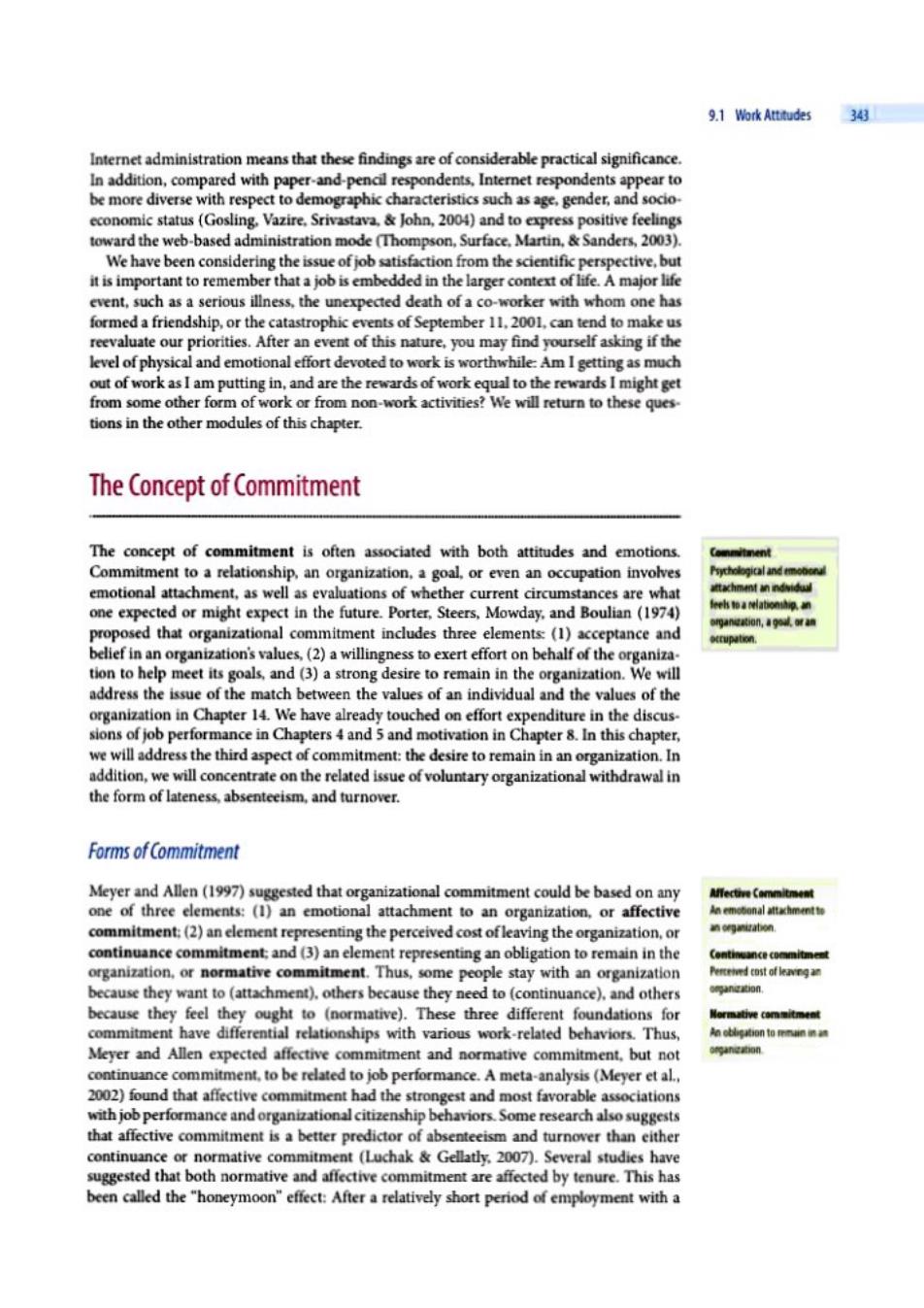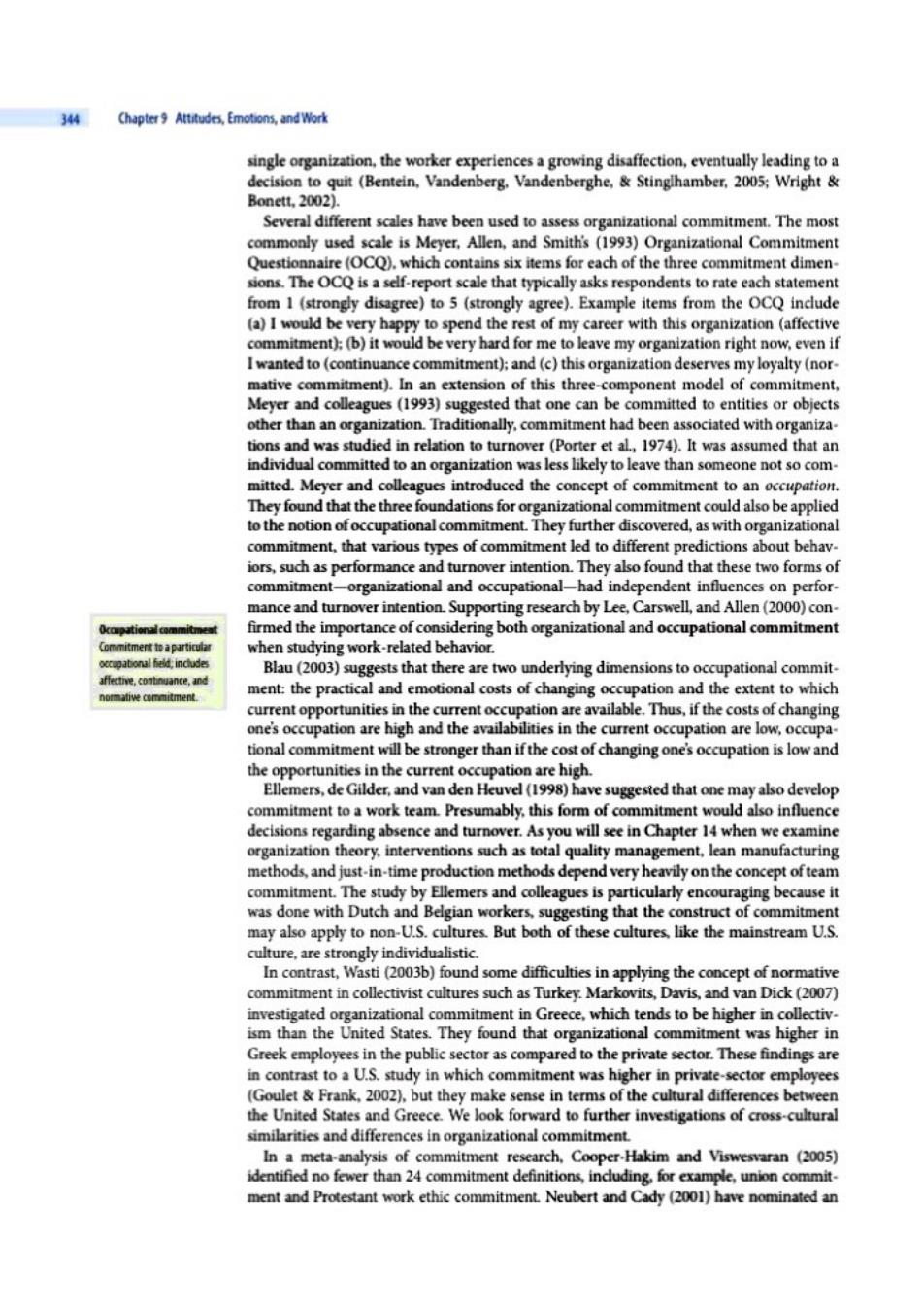
9.16kAtt山ds 343 Internet administration means that these findings are of considerable practical significance. In addition,compared with paper-and-pencil respondents,Internet respondents appear to be more diverse with respect to demographic characteristics such as age,gender,and socio- economic status(Gosling.Vazire.Srivastava.John,2004)and to express positive feelings toward the web-based administration mode (Thompson.Surface.Martin.Sanders,2003). We have been considering the issue of job satisfaction from the scientific perspective,but it is important to remember that a job is embedded in the larger context of life.A major life event,such as a serious illness,the unexpected death of a co-worker with whom one has formed a friendship,or the catastrophic events of September 11.2001.can tend to make us reevaluate our priorities.After an event of this nature,you may find yourself asking if the level of physical and emotional effort devoted to work is worthwhile:Am I getting as much out of work as I am putting in,and are the rewards of work equal to the rewards I might get from some other form of work or from non-work activities?We will return to these ques. tions in the other modules of this chapter. The Concept of Commitment The concept of commitment is often associated with both attitudes and emotions. Commitment to a relationship,an organization.a goal,or even an occupation involves emotional attachment,as well as evaluations of whether current circumstances are what one expected or might expect in the future.Porter,Steers,Mowday.and Boulian(1974) eels toa relationthig.an 6四une0n,49ed3第n proposed that organizational commitment includes three elements:(1)acceptance and ecrupation belief in an organization's values,(2)a willingness to exert effort on behalf of the organiza. tion to help meet its goals,and (3)a strong desire to remain in the organization.We will address the issue of the match between the values of an individual and the values of the organization in Chapter 14.We have already touched on effort expenditure in the discus- sions of job performance in Chapters 4 and 5 and motivation in Chapter 8.In this chapter, we will address the third aspect of commitment:the desire to remain in an organization.In addition,we will concentrate on the related issue of voluntary organizational withdrawal in the form of lateness,absenteeism,and turnover. Forms of Commitment Meyer and Allen(1997)suggested that organizational commitment could be based on any Affective Cammitment one of three elements:(1)an emotional attachment to an organization,or affective n emobonal attachment每 commitment:(2)an element representing the perceived cost ofleaving the organization.or 的9出a计0M. continuance commitment:and (3)an element representing an obligation to remain in the Continuance commmitment organization,or normative commitment.Thus,some people stay with an organization Pertetved cost of leavngan because they want to (attachment).others because they need to (continuance).and others because they feel they ought to (normative).These three different foundations for Hormative com mitment commitment have differential relationships with various work-related behaviors.Thus, Meyer and Allen expected affective commitment and normative commitment,but not continuance commitment,to be related to job performance.A meta-analysis (Meyer et al., 2002)found that affective commitment had the strongest and most favorable associations with job performance and organizational citizenship behaviors.Some research also suggests that affective commitment is a better predictor of absenteeism and turnover than either continuance or normative commitment (Luchak Gellatly.2007).Several studies have suggested that both normative and affective commitment are affected by tenure.This has been called the "honeymoon"effect:After a relatively short period of employment with a

344 Chapter9 Attitudes,Emotions,and Work single organization,the worker experiences a growing disaffection,eventually leading to a decision to quit (Bentein.Vandenberg.Vandenberghe,Stinglhamber,2005;Wright Bonett,2002) Several different scales have been used to assess organizational commitment.The most commonly used scale is Meyer.Allen,and Smith's (1993)Organizational Commitment Questionnaire (OCQ).which contains six items for each of the three commitment dimen- sions.The OCQ is a self-report scale that typically asks respondents to rate each statement from 1 (strongly disagree)to 5(strongly agree).Example items from the OCQ include (a)I would be very happy to spend the rest of my career with this organization(affective commitment):(b)it would be very hard for me to leave my organization right now,even if I wanted to (continuance commitment);and (c)this organization deserves my loyalty (nor- mative commitment).In an extension of this three-component model of commitment, Meyer and colleagues (1993)suggested that one can be committed to entities or objects other than an organization.Traditionally.commitment had been associated with organiza. tions and was studied in relation to turnover (Porter et al,1974).It was assumed that an individual committed to an organization was less likely to leave than someone not so com- mitted.Meyer and colleagues introduced the concept of commitment to an occupation. They found that the three foundations for organizational commitment could also be applied to the notion ofoccupational commitment.They further discovered,as with organizational commitment,that various types of commitment led to different predictions about behav. iors,such as performance and turnover intention.They also found that these two forms of commitment-organizational and occupational-had independent influences on perfor. mance and turnover intention.Supporting research by Lee,Carswell,and Allen(2000)con- firmed the importance of considering both organizational and occupational commitment when studying work-related behavior. oopabonal field:indudes Blau(2003)suggests that there are two underlying dimensions to occupational commit- affective.continuance,and normative commitment. ment:the practical and emotional costs of changing occupation and the extent to which current opportunities in the current occupation are available.Thus,if the costs of changing one's occupation are high and the availabilities in the current occupation are low,occupa- tional commitment will be stronger than if the cost of changing one's occupation is low and the opportunities in the current occupation are high. Ellemers,de Gilder,and van den Heuvel (1998)have suggested that one may also develop commitment to a work team.Presumably,this form of commitment would also influence decisions regarding absence and turnover.As you will see in Chapter 14 when we examine organization theory,interventions such as total quality management,lean manufacturing methods,and just-in-time production methods depend very heavily on the concept ofteam commitment.The study by Ellemers and colleagues is particularly encouraging because it was done with Dutch and Belgian workers,suggesting that the construct of commitment may also apply to non-U.S.cultures.But both of these cultures,like the mainstream U.S. culture,are strongly individualistic. In contrast,Wasti (2003b)found some difficulties in applying the concept of normative commitment in collectivist cultures such as Turkev.Markovits,Davis,and van Dick(2007) investigated organizational commitment in Greece,which tends to be higher in collectiv- ism than the United States.They found that organizational commitment was higher in Greek employees in the public sector as compared to the private sector.These findings are in contrast to a U.S.study in which commitment was higher in private-sector employees (Goulet Frank,2002),but they make sense in terms of the cultural differences between the United States and Greece.We look forward to further investigations of cross-cultural similarities and differences in organizational commitment. In a meta-analysis of commitment research.Cooper-Hakim and Viswesvaran (2005) identified no fewer than 24 commitment definitions,induding.for example,union commit. ment and Protestant work ethic commitment.Neubert and Cady (2001)have nominated an